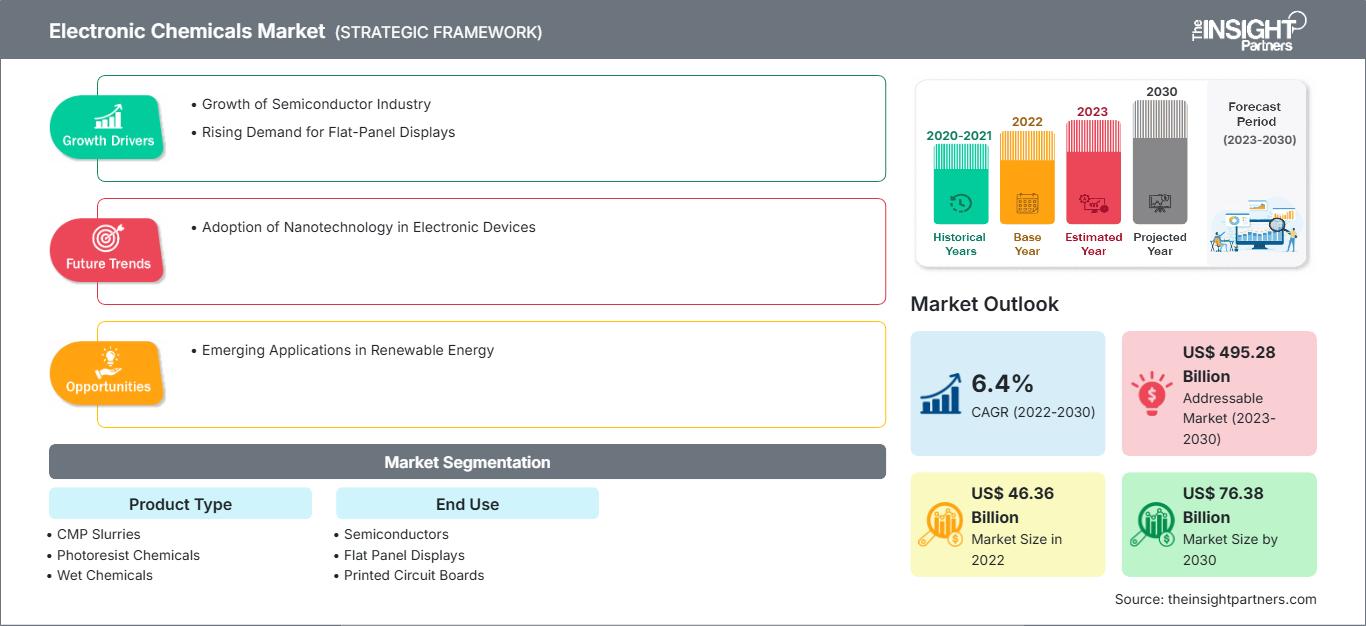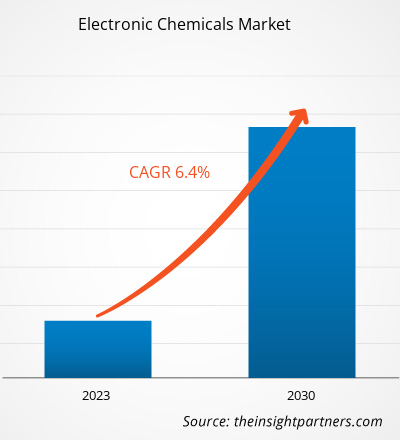[研究报告] 2022年,电子化学品市场规模为463.5895亿美元,预计到2030年将达到763.8314亿美元;预计2022年至2030年的复合年增长率为6.4%。
市场分析
电子化学品市场是全球电子行业的重要组成部分,为半导体制造和电子设备组装提供必要的材料和解决方案。该市场涵盖用于半导体制造工艺各个阶段的各种化学品,包括清洁剂、蚀刻剂、光刻胶、掺杂剂和沉积材料。这些化学品在生产日益复杂和微型化的电子元件(例如集成电路、微处理器、存储芯片和传感器)方面发挥着关键作用。电子化学品市场的主要驱动力是对更小、更快、更强大的电子设备的持续需求。随着消费者偏好转向紧凑型高性能设备,半导体制造商面临着持续的压力,需要开发尖端技术,突破小型化和效率的极限。这种需求推动了半导体制造工艺的不断发展,并日益重视先进材料和精密工程。由于对基于纳米技术的电子设备的需求不断增长,全球电子化学品市场规模到2030年可能会激增。
电子化学品在光伏制造中的应用日益广泛,为电子化学品市场的增长做出了重大贡献。电子化学品是光伏 (PV) 行业不可或缺的一部分,支持着可再生能源发电所必需的太阳能电池和电池板的生产。在太阳能电池的制造过程中,人们使用各种各样的化学品来控制半导体材料的特性,并确保光伏设备的效率和可靠性。电子化学品在光伏领域的一个关键应用是制造硅基太阳能电池,由于其高效率和可扩展性,硅基太阳能电池占据了相当大的市场份额。
增长动力与挑战
蓬勃发展的半导体行业和日益增长的平板显示器需求推动了电子化学品市场规模的不断扩大。不断扩张的半导体行业预计将成为电子化学品市场扩张的强大催化剂,推动对半导体制造所必需的各种化学材料和解决方案的需求。作为现代技术的支柱,半导体是各种电子设备不可或缺的一部分,包括智能手机、电脑、汽车电子产品和物联网设备。半导体行业对创新的不懈追求,其特点是不断追求更小、更快、更节能的电子元件,这需要使用先进的材料和精密的制造技术。此外,液晶显示器、有机发光二极管显示器和MicroLED显示器等平板显示器需要依赖电子化学品的复杂制造工艺。这些化学品用于清洁、图案化、涂层、封装和表面处理步骤,以制造平板显示器的各个层和组件。溶剂、表面活性剂和蚀刻剂等清洁剂用于去除玻璃基板和半导体层上的污染物、颗粒和残留物。然而,电子化学品对环境有不利影响。化学品泄漏、泄露和排放会污染水体,损害水生生态系统,并对野生动物构成风险。有机污染物、重金属和挥发性有机化合物因其可能造成长期环境损害而备受关注。许多电子化学品因其毒性和腐蚀性,会对工人的健康构成危害。接触酸、溶剂、金属和活性中间体等危险化学品可能导致急性或慢性疾病。许多监管机构和组织制定了严格的法规和安全标准,以保护人类健康。欧盟委员会的目标是到2030年将12种毒性最强的化学品的使用量减少50%。人们对电子元件毒性的认识不断提高,这可能会促使监管机构对制造商采取行动。
自定义此报告以满足您的要求
您将免费获得任何报告的定制,包括本报告的部分内容,或国家级分析、Excel 数据包,以及为初创企业和大学提供超值优惠和折扣
电子化学品市场: 战略洞察

-
获取本报告的主要市场趋势。这个免费样本将包括数据分析,从市场趋势到估计和预测。
报告细分与范围
《2030年全球电子化学品市场分析与预测》是一项专业且深入的研究,重点关注全球市场趋势和增长机遇。本报告旨在概述全球市场,并根据产品类型、最终用途和地区进行详细的市场细分。报告提供了该地区电子化学品使用情况的关键统计数据,以及主要国家/地区对电子化学品的需求。此外,报告还对影响主要国家/地区电子化学品市场增长的各种因素进行了定性评估。报告还对市场领先企业及其关键战略发展进行了全面分析。本报告还包括市场动态分析,以帮助识别关键驱动因素、市场趋势和有利可图的机会,从而有助于确定主要的收入来源。
生态系统分析和波特五力分析提供了全球电子化学品市场趋势的360度视角,有助于了解整个供应链和影响市场增长的各种因素。
细分分析
全球电子化学品市场根据产品类型和最终用途进行细分。根据产品类型,市场细分为CMP研磨液、光刻胶化学品、湿化学品、酸和其他。湿化学品细分市场占据最大的电子化学品市场份额。湿化学品涵盖针对特定应用定制的各种解决方案和配方,包括清洁、蚀刻、剥离和表面改性工艺。湿法化学品的主要用途之一是晶圆清洗,它可以去除半导体表面的污染物、残留物和颗粒,以确保最佳的器件性能和可靠性。清洗溶液可能包含酸、碱、有机溶剂、表面活性剂和螯合剂,这些成分经过精心配制,可以针对特定污染物去除,同时最大限度地减少对敏感材料的损害。蚀刻是湿法化学品促进的另一个重要工艺,该工艺选择性地从半导体基板上去除材料,以形成复杂的图案和特征。湿法蚀刻溶液通常由酸或碱组成,它们可以选择性地溶解某些材料,同时通过使用掩模或图案化技术保护其他材料。湿法蚀刻能够在半导体制造过程中精确定义器件结构,例如晶体管栅极和互连线。
根据最终用途,市场细分为半导体、平板显示器、印刷电路板、光伏器件和其他领域。半导体领域占据了最大的电子化学品市场份额。电子化学品在半导体行业中至关重要,因为它们在半导体制造过程的各个阶段都发挥着至关重要的作用。电子化学品的主要用途之一是清洁和表面处理。在进一步加工之前,半导体晶圆需要具有清洁均匀的表面,不含污染物、残留物和氧化物。电子化学品用于去除这些杂质,并确保表面为后续步骤做好准备。
区域分析
本报告详细概述了全球电子化学品市场的主要区域,包括北美、欧洲、亚太地区 (APAC)、中东和非洲 (MEA) 以及南美洲和中美洲 (SAM)。亚太地区占据最大市场份额,2022 年市场价值达 280 亿美元。亚太地区拥有大量电子产品制造商,是该地区中型企业的中心。预计到 2030 年,欧洲市场规模将达到 100 亿美元。预计北美电子化学品市场在 2022 年至 2030 年期间的复合年增长率约为 5%。亚太地区是全球技术消费品生产和出口中心,包括笔记本电脑、台式机、手机、收音机、音响系统和电视等消费电子产品以及其他重要电子零件和家用电器。中国、印度和韩国等亚洲国家/地区的车队车辆数量不断增长,推动了对印刷电路板 (PCB) 和半导体的需求。
竞争格局和主要公司
富士胶片控股公司、索尔维公司、巴斯夫公司、林德公司、霍尼韦尔国际公司、松原工业株式会社、日立高科技公司、RBP 化学技术公司、PVS 化学解决方案公司和 Esprix Technologies LP 是电子化学品市场报告中介绍的知名企业。此外,本报告还研究和分析了其他几家企业,以全面了解市场及其生态系统。电子化学品市场报告还包括企业定位和集中度,以评估市场中竞争对手/参与者的表现。
电子化学品市场区域洞察
The Insight Partners 的分析师已详尽阐述了预测期内影响电子化学品市场的区域趋势和因素。本节还讨论了北美、欧洲、亚太地区、中东和非洲以及南美和中美洲的电子化学品市场细分和地域分布。
电子化学品市场报告范围
| 报告属性 | 细节 |
|---|---|
| 市场规模 2022 | US$ 46.36 Billion |
| 市场规模 2030 | US$ 76.38 Billion |
| 全球复合年增长率 (2022 - 2030) | 6.4% |
| 历史数据 | 2020-2021 |
| 预测期 | 2023-2030 |
| 涵盖的领域 |
By 产品类型
|
| 覆盖地区和国家 |
北美
|
| 市场领导者和主要公司简介 |
|
电子化学品市场参与者密度:了解其对业务动态的影响
电子化学品市场正在快速增长,这得益于终端用户需求的不断增长,而这些需求的驱动因素包括消费者偏好的不断变化、技术进步以及对产品优势的认知度不断提高。随着需求的增长,企业正在扩展产品线,不断创新以满足消费者需求,并抓住新兴趋势,从而进一步推动市场增长。

- 获取 电子化学品市场 主要参与者概述
行业发展和未来机遇
以下列出了电子化学品市场主要参与者采取的一些举措:
- 2024年2月,利用化学信息学和材料信息学,为金属薄膜材料的高效开发做出贡献。
- 2023年9月,索尔维在台湾成立了最先进的电子级过氧化氢合资企业。
- 历史分析(2 年)、基准年、预测(7 年)及复合年增长率
- PEST和SWOT分析
- 市场规模、价值/数量 - 全球、区域、国家
- 行业和竞争格局
- Excel 数据集
近期报告
相关报告
客户评价
购买理由
- 明智的决策
- 了解市场动态
- 竞争分析
- 客户洞察
- 市场预测
- 风险规避
- 战略规划
- 投资论证
- 识别新兴市场
- 优化营销策略
- 提升运营效率
- 顺应监管趋势






















 获取免费样品 - 电子化学品市场
获取免费样品 - 电子化学品市场